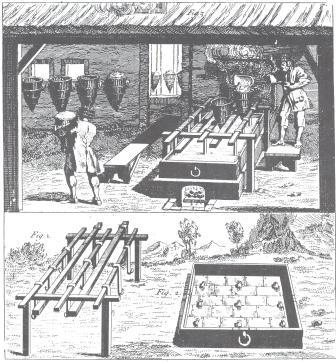Active fieldwork has finished but work continues in trawling through documentary and cartographic sources to inform the findings of the salt project. For our flagship site at Ballycastle the archives at the Public Record Office of Northern Ireland (PRONI) have been most useful and fascinating. As well as Ballycastle they contain much of interest on Killough in Co. Down, and Carrickfergus in Antrim (which our visit to the Cheshire Archives also focused on).
Key material relates to the Earl of Antrim’s estate, and although much is concerned with leases, indentures, court cases, debts and other legal wrangling (there was an awful lot of wrangling!) there is much to inform our project. One find of interest was the salt works account book for 1787-8 , which relates to the later site at Broughanlea where the impressive evaporation pans were excavated.
There are charges relating to transporting coal and importing rock salt, and also the export of Ballycastle salt on Scottish boats. We also find building materials, including timber, nails, brick, lime and both slates and ‘straw for thatch’. This demonstrates that some of the buildings were quite naturally taking precautions against the coal fires under the pans, while others, likely storehouses, could continue with thatch. Payment for locks underlines the need to secure the works housing valuable quantities of salt and coal.
Then there are the items relating directly to the production of salt and the maintenance of the facilities: 20 dozen salt-baskets (£6.11s.7½d) and mending salt-baskets (£1.1s.1d), shovels (3s), ‘bearing creels’ (2s.8d), ‘sacking, twine and making bags’ (£1.17s.8d), buckets (14s.7d) and eggs (8½d). The latter (egg whites) were added to the brine to attract impurities which were subsequently skimmed off. Pan-plates (£12.1s.9d) are also listed, no doubt to make repairs or as spares.

William Brownrigg’s famous illustration of 18th-century salt-making in progress – featuring baskets, shovels, the pans and timber supporting frame.
There are expenses relating to general labouring, and also skilled tradesmen such as masons, carpenters, the salt-makers themselves and the salaries of the supervisors at the works. Importantly too were individuals paid for mending the pans (£2.6s) and cistern (5s.5d). It is not clear whether the cistern is the bucket pot on the shore or more likely a tank set by the pans into which rock salt was added to sea water to create the brine. Regardless it must have been thirsty work as £1.7s is listed to pay for ‘drink to the men cleaning the cistern’!

Good to hear of your progress.
I think the illustration you have used from Brownrigg (illustration V) is his re-drawing of Agricola’s illustration from De Re Metallica, and not representative of eighteenth century salt making.
Brownrigg’s contemporary drawings of a marine salt works of his time are his Illustrations II, III and IV. Illustration VI is of salt pans he describes as formerly used in Cheshire being a re-drawing of William Jackson’s article published in the Royal Society in 1669.
Well spotted Andrew. We are not suggesting this is necessarily exactly representative of our site at Ballycastle, and it certainly differs in some notable ways. Interestingly we note Brownrigg does state this arrangement was still in use in Germany, and recently in England in his account.